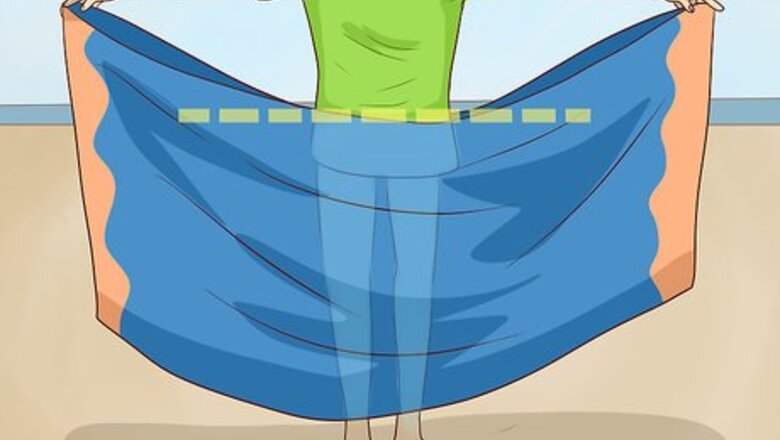
views
X
Research source
Learning how to fasten the lungi so it stays in place takes practice, but once you learn how to do it you can get dressed quickly and with confidence.
Tying a Traditional Long-Style Lungi

Step into the tubular lungi and position it slightly above your waist. The excess material on either side of your body should be equal on the left and the right (your body is in the center of the lungi—no fabric is touching either side of your body yet). Position the lungi above your waist to give yourself space to roll and tie the lungi in future steps without it riding too low on your body.
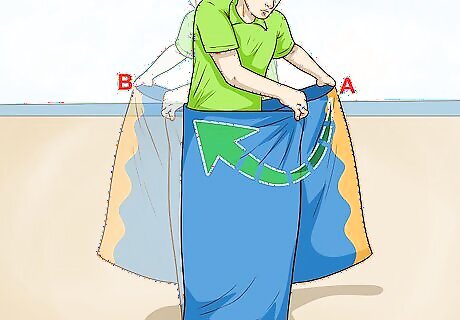
Pull the right side to the left waist and the left side to the right waist. Pull them at a slight downward angle so that the first layer of the lungi remains as a single swath of fabric across your belly. Suck in your stomach while you do this—you want to lungi to be tight. When you finish, your arms will be crossed in front of you. It may feel a little awkward, but don't worry!
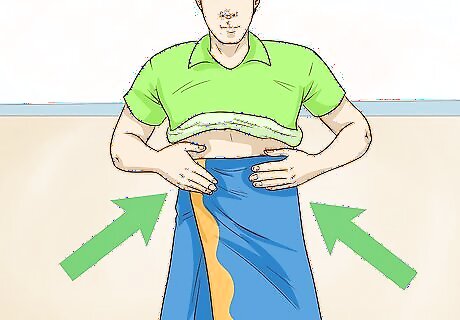
Uncross your arms while keeping the lungi in place. This may be a little tricky at first and you might need to use your elbows to hold it up as you move your hands back to their original side. Let go of the right side first and grasp the left side and then move your right hand back to the right side rather than letting go of both pieces at once. Once you have practiced a bit, you should be able to do this move pretty fluidly. Don't worry if you drop your lungi at first—just keep practicing until the movements feel more natural.

Fold down the middle swath of fabric to create a roll. Fold down the back as well as the front. The material will go over the left and right sides that you originally crossed over your body. This makes a sort of belt for your lungi. Roll the fold at least 1 more time, or as many times as you want to get your desired length. Folding the sides downward (rather than straight across your stomach) before creating the roll from the main swath gives your legs a little more space to stretch and move around comfortably. Instead of having straight sides the material should flow around you a little bit more.
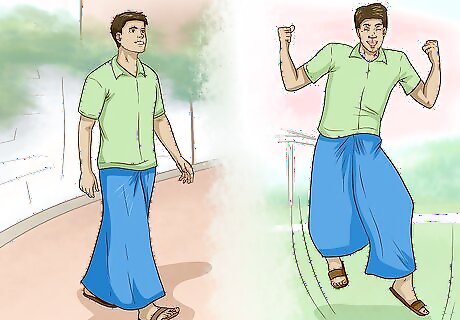
Test out your lungi by jumping and moving around. This is essential before leaving your house! Make sure the lungi stays in place and doesn't easily come undone. Though you can adjust and re-roll your lungi while out in public, you want a stable foundation so the whole piece doesn't fall down around you. Try sitting down and getting back up, too, to see how the lungi feels. If it is too tight or feels uncomfortable when you sit down, try loosening the folds a little bit.
Fastening a Short-Style Lungi
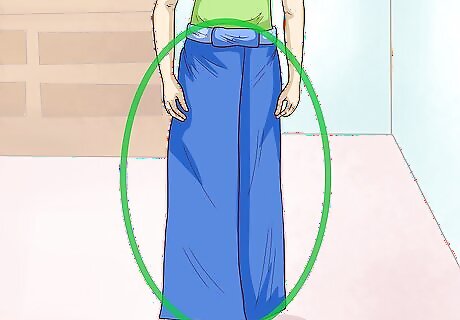
Follow the instructions to fold your lungi the traditional way. Starting with a solidly tied lungi will give you the base to make your long lungi into a shorter one with fewer mishaps. Wear a shorter lungi if it is particularly hot outside or if you are going to be wading in water and want to keep your lungi dry. Test out the long lungi by jumping and walking around a little bit to make sure it is secure before moving on to the next steps.
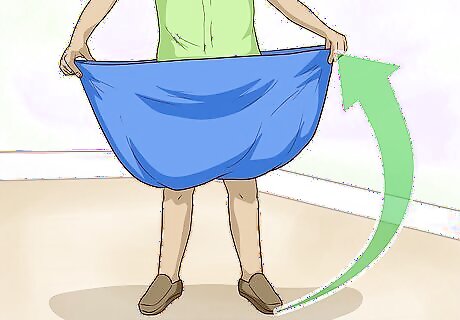
Grab the bottom of your long lungi and bring it up around your waist. Hold the hem of the fabric and bring it upward so it is inside out. Hold the material at equal lengths on each side of your waist, like you did in the beginning, and fold each side across your body again. Remember to fold the lungi sides in a slight downward angle to leave that middle swath of fabric to use as a belt.
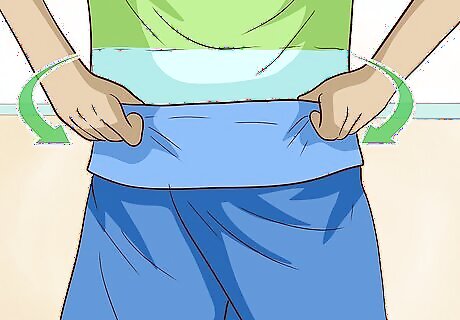
Fold the top of the lungi down to capture the new folds. Adjust how many rolls you make based on how long or short your want your modified lungi to be. Remember to roll the lungi down all the way around, not just in the front. This again creates a “belt” to keep your lungi in place. If you are wearing a very short lungi, it's a good idea to wear something underneath.
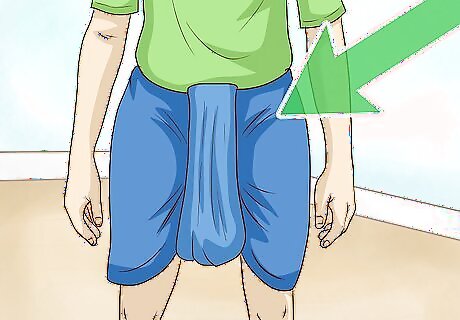
Create a pair of “shorts” with your lungi as an alternative. Instead of creating a shorter lungi where you might be accidentally exposed, you can also take your long lungi, grab the excess fabric in the back and gather it in your hands. From there, bring the fabric in between your legs to the front of your body and tuck the excess fabric into the waist at your back. When you are putting the fabric between your legs, don't pull the material too tightly as this could make the “legs” of your lungi uncomfortable. Try to keep it looser. This option won't look like a traditional pair of shorts exactly, but it will keep you cool.
Styling Your Lungi

Add a collared, button-up shirt for a more masculine look. It can be either long- or short-sleeved. Choose a shirt with buttons so you can undo it when you get hot during the day. Leave your shirt untucked from the lungi. Traditionally in India, men wear button-up shirts with their lungis or go shirtless. If you're wearing a lungi in the US or a European country, this might not be as socially acceptable, but if you're in southern Indian states, going shirtless on a hot day is normal.

Pair a plain shirt or blouse with your lungi for a feminine look. Or, if you have a plain-colored lungi, pair it with a patterned shirt. Get creative with your coordination! Lungis are very versatile pieces of clothing and let you mix and match different styles as you prefer. Leave your shirt untucked from your lungi. Women seem to wear the lungi less often than men, but recently more and more women have been taking advantage of this fashion style.
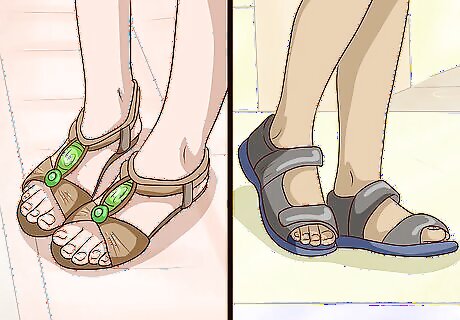
Wear sandals with your lungi. Traditionally, people in India wear sandals with straps with their lungis. Choose a pair of sandals that have thick soles and straps to keep them securely on your feet rather than thin-soled thongs. You can also wear tennis shoes with your lungi, especially if you are going to be walking around town a lot.

Pair fun accessories along with your lungi. Scarves, necklaces, bags, and hats are all fun options to mix and match with your lungi. Look for complementing colors and light fabrics. For a more feminine look, you could also wear a headband made of the same fabric of your lungi. Look for options that draw your eye rather than just ones you think are traditionally popular.
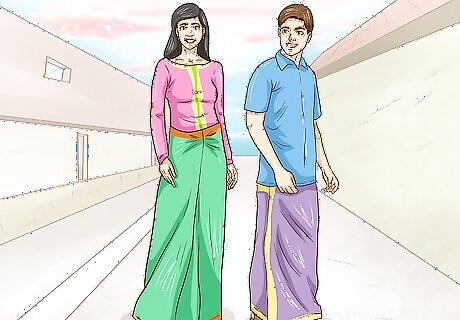
Choose a lungi for casual settings. A lot of people view the lungi as the outfit they change into once they are home from work or when they are out running simple errands. Formal functions, like a wedding or an office job, might not be the most appropriate place for a lungi. Laborers do often wear lungis to work as they help keep them cool.















Comments
0 comment